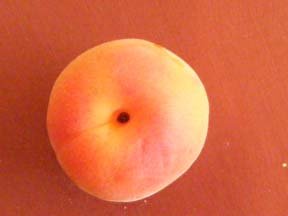[Letter from Denise Branch, School Board Chair]
Dear Parents & Community Members:
As you may know, Dr. Ty Wessel, who served our district as superintendent for the past few years, has resigned to accept a leadership role with the Traverse Bay Area Intermediate School District. As a board, we are in the process of searching for a new permanent superintendent and are sending this communication to request your assistance. We have contracted with the Michigan Leadership Institute to assist us with the search and with the recruitment of candidates.
A key to those recruitment efforts is development of a profile of our ideal next superintendent. We are requesting your thoughts on what qualities, characteristics and skills we should be seeking in a new superintendent. It is our objective to have a draft of this profile by August 22, based upon the feedback we receive from as many members of the Northport staff, parents and community as possible. To that end we are requesting that you share your thoughts with us at your earliest convenience. You can do so by responding via email at denise@leelanauproperty.com or by faxing your thoughts to (231)386-7094, or by mailing your thoughts to Denise Branch, Northport Public School, P.O. Box 188, Northport, MI 49670.
The calendar for our search is included below. Please make note of the November dates for interviews. All interviews are open to the public, and we encourage you to attend and submit your questions for the candidates. Our objective is to continue the excellent education that our children receive here in the Northport school system, and we look forward to your assistance and support in pursuit of that end. Thanks for your help and continuing support of the Northport Public Schools.
Sincerely,
Denise Branch
President, Board of Education
August 25 Candidate recruitment begins
October 17 Deadline for applications
October 17 – 27 Candidate screening and reference checks
October 27 Board determines finalists for interview
*November 3 – 5 Initial candidate interviews
November 5 Board determines finalists
*November 10 – 11 Second interviews
November 17 Board visit to final candidate’s district of employment
November 24 Appointment of new superintendent
No later than July 1, 2009 Start date (negotiable)
If you enjoy following Books in Northport, share a link with your friends. Sharing is good. Pass it along.
Search This Blog
Wednesday, July 30, 2008
Tuesday, July 29, 2008
Monday, July 28, 2008
Poetry Tomorrow Evening
 Come to the Leelanau Township Library tonight at 7:30 p.m., with a poem or poems of your own to read to the gathered multitude (don’t I wish!), or simply come to listen to, laugh with pleasure over, and applaud the poems of others. Poetry Night is pure enjoyment. You’ll be among friends, even if you haven’t met any of them before, and there is no pressure at all to perform—or, if you do, to come off like Shakespeare. There are no lower or upper age limits. If you’re a little afraid of poetry, dare yourself to do something different: come and listen and let the words wash over you like a fresh summer rain. As my grandmother used to tell me when the clouds opened and we didn’t have an umbrella with us, “You’re not sugar—you won’t melt!” Or maybe you are and will, but it will feel good.
Come to the Leelanau Township Library tonight at 7:30 p.m., with a poem or poems of your own to read to the gathered multitude (don’t I wish!), or simply come to listen to, laugh with pleasure over, and applaud the poems of others. Poetry Night is pure enjoyment. You’ll be among friends, even if you haven’t met any of them before, and there is no pressure at all to perform—or, if you do, to come off like Shakespeare. There are no lower or upper age limits. If you’re a little afraid of poetry, dare yourself to do something different: come and listen and let the words wash over you like a fresh summer rain. As my grandmother used to tell me when the clouds opened and we didn’t have an umbrella with us, “You’re not sugar—you won’t melt!” Or maybe you are and will, but it will feel good.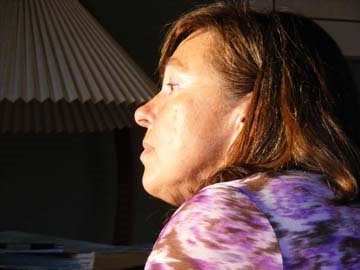 Late yesterday afternoon we trekked around Grand Traverse Bay (stopping at Altonen’s farmstand to buy a peach praline pie) all the way to Eastport, where our friend Micki gave her annual piano recital for, and served home-cooked Greek dinner to, friends from as far away as South Haven. Strains of Bach, Hayden and Chopin drifted through the house and out the windows across the lawn on the soft summer air, the last rays of the setting sun streaming across the Bay from the west.
Late yesterday afternoon we trekked around Grand Traverse Bay (stopping at Altonen’s farmstand to buy a peach praline pie) all the way to Eastport, where our friend Micki gave her annual piano recital for, and served home-cooked Greek dinner to, friends from as far away as South Haven. Strains of Bach, Hayden and Chopin drifted through the house and out the windows across the lawn on the soft summer air, the last rays of the setting sun streaming across the Bay from the west. Traffic was light on our way home, and we took a detour through the town of Elk Rapids, lively with bicycles at dusk. Little Paradise Pines looked like tourist cabins from the 1940’s. “You could make a film there,” David commented. Another of my favorite motels to spot is the Crestwood in Acme. In my eyes, these modest places have so much character that I treasure each surviving example. Passing the state park campground in Traverse City, we remarked the odor of campfire smoke, evocative of so many memories.
The evening shimmered, evanescent.

Sunday, July 27, 2008
Never Enough Time
 No matter how long Sarah and her friends play together, they could always play longer. For me, there’s never enough time, either. Not enough time for gardening, for visiting with friends, for lying on my back in the grass looking at the sky—never enough time simply to look and look and look at the world around me. So it probably goes without saying that there’s never enough time for reading, either. As the name of my friend Gloria’s bookstore in Traverse City has it, “So Many Books, So Little Time”!
No matter how long Sarah and her friends play together, they could always play longer. For me, there’s never enough time, either. Not enough time for gardening, for visiting with friends, for lying on my back in the grass looking at the sky—never enough time simply to look and look and look at the world around me. So it probably goes without saying that there’s never enough time for reading, either. As the name of my friend Gloria’s bookstore in Traverse City has it, “So Many Books, So Little Time”! I suffer no shortage of “reading material” around me. (That phrase reminds me of another that David detests: “forest products.”) Does that make the shortage of reading time easier or more tormenting? While thinking yesterday about writing this post, I made notes of four books recently begun, none of them yet finished, and then last night I fell into a fifth. What can I say? Occupational hazard?
THE BOOK THIEF (Knopf pb, 2007), by Markus Zusak, is a novel I mentioned not long ago wanting to read. It starts off kind of stop-and-go, with Death, if you please, as the narrator, but don’t let that put you off. In a matter of pages, I was drawn into the story, and this may turn out to be the first book of the five that I finish, as I am devouring it at high speed. Promissory note: more on this book in the week to come.
BRANDEIS AND THE MODERN STATE (1933), by Alpheus Thomas Mason, is a totally different kettle of fish. I’m interested in history and the court system, however, and this book is just the size I like to hold, which sounds like a trivial consideration but which always counts with me.
L’AIGUILLE CREUSE (1909), by Maurice LeBlanc, is the third in a French pulp series about a master burglar. Noises in the middle of the night! Men seen running from the chateau, carrying large objects! A brave young woman with a gun! A high school student wearing a false beard and posing as a journalist! I’m told that the burglar turns detective later in the series. Pulp fiction is good for conversation-building in another language, and this series is old enough that I won’t worry about saying something indecent if I pick up a few new phrases.
THE LAST HOURS OF ANCIENT SUNLIGHT: WAKING UP TO PERSONAL AND GLOBAL TRANSFORMATION (rev. ed., 1999), by Thom Hartmann, sounds like a self-help book but turns out to be an engaging treatise on technology, economics and the environment. I’m dipping here and there in the book, not reading the chapters in order.
Finally, Bruce gave me a copy of THE DUCHESS OF BLOOMSBURY STREET (1973), by Helene Hanff, a sequel to her popular story (so beloved by book people), 84 CHARING CROSS, and this is the book I read last night before falling asleep, having been glued to THE BOOK THIEF for as many fractions of an hour as I could steal for it throughout the day. London was Hanff’s magic city, as Paris is mine. Here is how she describes her delight in finally being there:
“I walked slowly along the street, staring across it at the houses. I came to the corner, to a dark little park called Bedford Square. On three sides of it, more rows of neat, narrow brick houses…. I sat on a park bench and stared at the houses. I was shaking. And I’d never in my life been so happy.
“All my life I’ve wanted to see London. I used to go to English movies just to look at streets with houses like those. Staring at the screen in a dark theatre, I wanted to walk down those streets so badly it gnawed at me like hunger. Sometimes, at home in the evening, reading a casual description of London by Hazlitt or Leigh Hunt, I’d put the book down suddenly, engulfed by a wave of longing that was like homesickness.”
The success of 84 CHARING CROSS, she writes, changed her life. While the book didn’t make her rich or famous, it did make friends for her, boosted her self-esteem and took her to England. In other words, it made come true her dream of a lifetime. What more could any author ask?
Friday, July 25, 2008
Guest Columnist: Al Bona Speaks Out

[The daisies in the meadow are here to help us--me, certainly--remember all that's good in the world, even while critiquing crimes and blunders. Our friend Al has very strong and well-informed opinions on financial practice. As his opinions are at least as strong as mine and certainly better-informed, I asked him if he would be willing to let me post his views on the current financial crisis, and this is the letter he gave me in response. The Traverse City Record-Eagle said it was too long to publish. Al insists there is nothing he could eliminate and still tell the whole story. --pjgrath]
For nearly thirty years I was the president of a savings and loan (S&L) association. During that time I was also a director of two unrelated commercial banks and for a time chairman of the board at one of them. That experience gives me a unique binocular view of the present worldwide financial disaster, which we erroneously refer to as the subprime mortgage meltdown.
I say “erroneously” because this appellation, “subprime,” emphasizes secondary causes that economists and Wall Street gurus identify as “careless lending” and “careless borrowing.” To be sure, these are contributing factors, but they are a long way downstream from the polluted well which is the source of the present epidemic.
There are two root causes. One is the market practice of packaging mortgages and then “securitizing” those packages in the form of bonds. This process widely distributes ownership and relieves the original lenders of responsibility and financial consequences. The second cause is the adjustable rate mortgage (ARM).
Prior to 1983, S&L’s were prohibited from making ARM’s and balloon loans. They were required to make only fixed-rate, long-term loans. These conditions were expressly written into the Federal Home Loan Act of 1933 (a year in which we enjoyed an uncommonly wise Congress).
The ARM is an unsafe and unsound instrument for underwriting mortgage loans because interest rates are unpredictable, and the underwriter (bank or S&L) has no way of knowing whether or not the borrower will be able to make payments in the future. In the present market system, the risk to the lender under the terms of an ARM is mitigated or passed on to others by the process of “securitizing” in the form of bonds secured by large packages of ARM’s. In this way, the risk is passed on from the original lender to the bondholder. A very slick trick!
Another effect of this process of turning mortgages into bonds is that responsibility is so widely scattered that it loses identification. Your mortgage may be owned, simultaneously, in part by a bond trader on Wall Street and in part by a bank in Zurich or Hong Kong or a private investor in Chicago. As the borrower, when the interest rate rises so high that you can no longer make the payments on your loan, you have no one to turn to, no avenue of appeal. Even the banker who originated the loan is powerless: he is left with no authority to re-negotiate the terms of the loan. All he can do is to initiate foreclosure on behalf of the bondholders (unknown to him) when you fail to make your payments.
Fifty years after the Federal Home Loan Act of 1933, Ronald Reagan “deregulated” financial institutions. I will mention a few results of the 1983 deregulation:
(1) The prime rate rose to 21.5%.
(2) Bankruptcies and foreclosures went through the roof.
(3) Jumbo (insured) certificates of deposit earned 15% interest.
(4) The majority of S&L associations were destroyed.
(5) ARM’s and balloon notes became common banking practice.
Now, about twenty-five years after deregulation, we are visited by another wave of consequences following from Reagan’s disastrous folly. He promised to get government off our backs. He succeeded—only to hang the uncontrolled, morally unconscious, “free” financial market around our necks. The people who are paying the most for this cavalier exercise in ignorance are, as before, the least advantaged among us.
What is the long-term cure? It’s simple. We should once again outlaw the inherently unsafe and unsound adjustable rate mortgage.
-- Al Bona, Northport
[Bookseller/editor’s note: putting acronyms into plural form is my bête noire. Though the HARBRACE COLLEGE HANDBOOK tells me I can go with or without the apostrophe, I don’t like either way: the plural looks like a possessive with an apostrophe but clumsy without. This time around my flipped coin came up apostrophe. I am not, however, soliciting comments on the use of apostrophes! Al is hoping for substantive reaction to his ideas.]
Thursday, July 24, 2008
Northern Happenings
 Elizabeth Buzzelli did a stellar job speaking at the library on Tuesday. I’m sorry not to have posted the news of her appearance sooner, but to make up for that lapse I’m announcing here and now that she will be teaching a one-day intensive writing seminar, through NMC, on August 9. I wish I could go! It is, however, a Saturday in August, not to mention Northport Dog Parade Day, but those of you nearer to Traverse City and more dedicated to the pen than the pooch will want to check out this opportunity before the class fills up. You’ll get your tuition’s worth. By the by, she’d been hoping for a “dark and stormy night,” when planning her evening presentation on how we scare ourselves with stories involving gruesome gore, but we had beautiful skies in place of thunder, and that worked out fine.
Elizabeth Buzzelli did a stellar job speaking at the library on Tuesday. I’m sorry not to have posted the news of her appearance sooner, but to make up for that lapse I’m announcing here and now that she will be teaching a one-day intensive writing seminar, through NMC, on August 9. I wish I could go! It is, however, a Saturday in August, not to mention Northport Dog Parade Day, but those of you nearer to Traverse City and more dedicated to the pen than the pooch will want to check out this opportunity before the class fills up. You’ll get your tuition’s worth. By the by, she’d been hoping for a “dark and stormy night,” when planning her evening presentation on how we scare ourselves with stories involving gruesome gore, but we had beautiful skies in place of thunder, and that worked out fine.
Downed by migraine a week ago Tuesday, I was forced to take a break from the nonstop pace of summer, and it felt so good (despite the cause) that I haven't wanted to go at a breakneck speed again since then. David feels the same way. Wednesday brought us a small taste of summer vacation. Bruce was at the bookstore, it was my house-and-garden day, and as I was coming in from weeding to get another load of laundry out of the washer to hang on the line the phone rang. It was my sister, calling from Mackinac. Her husband had raced in the Mac from Chicago, she’d driven up to meet him, and they were now starting back south and had just enough leeway to stop and visit briefly on their way. No time for me to go to town to shop, but there was beer and ginger ale (Vernor’s, of course), and inspiration pushed me out to the car and up the road to buy some fresh local cherries. The temperature was perfect. The sunshine was perfect. My gardens glistened from their morning watering.
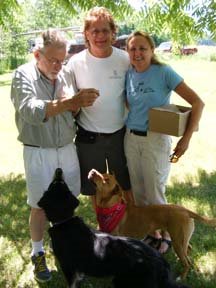 We sat at the umbrella table under the black walnut tree, as if there were no such thing as work. This put the cap on Sarah’s wonderful morning. Being out in the yard for hours, with me and her friend, Kona, and then having company besides--!!! Both dogs enjoyed the social hour as much as the human beings did.
We sat at the umbrella table under the black walnut tree, as if there were no such thing as work. This put the cap on Sarah’s wonderful morning. Being out in the yard for hours, with me and her friend, Kona, and then having company besides--!!! Both dogs enjoyed the social hour as much as the human beings did.This morning I finished Richard Hill’s LAKE EFFECT and enjoyed it very much. In fact, one peripheral thought it put in my mind was the whole subject of self-publishing: what kinds of books succeed when self-published, what it takes for success, and when aspiring writers would be better off simply printing a few copies for their relatives. LAKE EFFECT is worth its cover price, and I’ll have no trouble recommending it. Another time I’ll go down my list and say why, citing other well-done, self-published books.
NORTHPORT CALENDAR:
Saturday, July 26, is the pig roast and family festival benefiting the Leelanau Children’s Center. The meal is free for kids under 5 years of age, with meals for kids 5-12, $5, and adults $15. The pig roast will be at the marina park in Northport, 3-6 p.m. (at the school in case of rain).
Tuesday, July 29, is the final evening of the Leelanau Township Library summer series, and it’s Poetry Night! Bring a poem you’ve written (more than one, if you’d like), or just come to enjoy and applaud. My personal theme this year is “You don’t have to be afraid of poetry!” Some of our local poets are very serious, others produce humorous verse, but there is a lot of variety, and Poetry Night last year was a huge success, moving right along, with lots of laughter and appreciation.
Thursday, July 31, is Gallery Walk again. All the galleries in Northport will be open from 6-9 p.m. We will hope for a pleasant strolling evening, as all but two of the galleries are right in the village.
Saturday, August 9, is the always eagerly awaited Northport Dog Parade. This year’s theme is “Indiana Bones and the Raiders of the Lost Bark,” so plan your costumes and floats accordingly. Registration for the 2008 parade can be done early in the day, to save time, at Dog Ears Books or at the Northport Bay Dog and Cat Company.
Saturday, August 16, is another wonderful annual event, the fly-in at Woolsey Airport, with pancake breakfast from 8 a.m. to noon ($4 children; $8 adults). The band will play, and there will be vintage cars on display, as well as all manner of small planes. My advice: Plan to arrive early to see the planes coming in and to get your breakfast before the line is too long.
I don’t have a poster yet for the food and wine festival in Haserot Park, but that should be August 9, and if scheduling this year is the same as most years, the pow-wow at Peshawbestown should be August 15, 16 and 17. I’ll give definite word on that when it comes my way.
Tuesday, July 22, 2008
Come to Northport Tonight!
Tonight author Elizabeth Kane Buzzelli will speak at the Leelanau Township Library at 7:30 p.m. Elizabeth’s new book, DEAD DANCING WOMEN, will be out this fall, with another book featuring the crime-solving Emily Kincaid available in 2009. Buzzelli writes a gardening column, book reviews and features for the Traverse City Record-Eagle and frequently teaches writing classes through NMC. She led a writing workshop at Dog Ears Books in March of 2007 for a dozen eager learners and kept us all on our toes every minute. Elizabeth is one of those people born to write, someone who is never not writing or thinking about it. She's an inspiration and a delight.
Sunday, July 20, 2008
What a Day May Bring
Naturally, there are as many visual images to choose from as moments in the day, but my camera does not capture them all. Here are a few unconnected ones from yesterday.
 First, someone apparently spilled quite a bit of food from a bag of dry dog kibble out onto Waukazoo Street, and a couple of gulls were not long in finding the banquet. This was the bolder of the two, the one not scared off when cars passed close by. Please note also the beautiful new paving of the street in front of Dog Ears Books. Our downtown is beautiful this summer--and this street cleaner was working for free!
First, someone apparently spilled quite a bit of food from a bag of dry dog kibble out onto Waukazoo Street, and a couple of gulls were not long in finding the banquet. This was the bolder of the two, the one not scared off when cars passed close by. Please note also the beautiful new paving of the street in front of Dog Ears Books. Our downtown is beautiful this summer--and this street cleaner was working for free!
 We had a visit later in the day from good friend and Hemingway aficionado Ron Bauer of Grand Haven and Cherry Home, seen here wearing his vintage Dog Ears Books t-shirt, circa 2004 (?). He and David regaled one another and me with many wonderful stories, but in this picture Ron is reading aloud to us a couple of paragraphs from Hemingway’s short story, “The Big Blow,” because within those paragraphs is a phrase that he (Bauer, not Hemingway) thought David should use sometime for a painting title. (No, I’m not telling.) At closing time we adjourned to the marina to continue story-telling over a pizza from the Eat Spot.
We had a visit later in the day from good friend and Hemingway aficionado Ron Bauer of Grand Haven and Cherry Home, seen here wearing his vintage Dog Ears Books t-shirt, circa 2004 (?). He and David regaled one another and me with many wonderful stories, but in this picture Ron is reading aloud to us a couple of paragraphs from Hemingway’s short story, “The Big Blow,” because within those paragraphs is a phrase that he (Bauer, not Hemingway) thought David should use sometime for a painting title. (No, I’m not telling.) At closing time we adjourned to the marina to continue story-telling over a pizza from the Eat Spot.
 Home at last, it doesn’t take a fortune-teller to guess that Sarah and I hit the fields and woods so she could stretch her dog legs after a long day of good behavior in the bookstore. The first of the summer’s Queen Anne’s Lace are beginning to bloom in the heavy, humid air of July.
Home at last, it doesn’t take a fortune-teller to guess that Sarah and I hit the fields and woods so she could stretch her dog legs after a long day of good behavior in the bookstore. The first of the summer’s Queen Anne’s Lace are beginning to bloom in the heavy, humid air of July.
Not captured on camera was a visit early in the day from Richard and Judy Hill of Sault Ste. Marie, bringing with them Rich’s new book, LAKE EFFECT: A DECKHAND’S JOURNEY ON THE GREAT LAKES FREIGHTERS. Nice people, an engaging, exciting book, which I’m happy to have (signed copies!) in the store, and I don’t think Rich will mind if I quote a bit here from the opening of the first chapter to show you how it reeled me in:
“The early morning mist hovered over the quiet waters of the St. Mary’s River, slightly obscuring the passing freighters. The rocks along the bank where I sat felt damp and mossy. Further down the river, in the narrow channel, the ferry sounded a muffled horn blast as it departed for Sugar Island. Along the Canadian side of the river, the sugar maples blushed as they awoke in the chill fall air.”
Well, I’m there! The Soo is nowhere else on earth, and I’ve never been on a Great Lakes freighter before. There’s some raw language, lots of technical and mechanical information, and I predict this is a book men will be nuts about, but I’m loving it, too. There’s even a connection for me to my growing up in Joliet, Illinois, where the railroad that employed my father was bought out by U.S. Steel (the company operating the freighters Rich writes about) to bring taconite from the Mesabi Range down to Gary, Indiana.
What a surprise. I thought I’d be starting a novel today, and here I am, out on open water, out of sight of land, heading back to Two Harbors, Minnesota. You never know.
 First, someone apparently spilled quite a bit of food from a bag of dry dog kibble out onto Waukazoo Street, and a couple of gulls were not long in finding the banquet. This was the bolder of the two, the one not scared off when cars passed close by. Please note also the beautiful new paving of the street in front of Dog Ears Books. Our downtown is beautiful this summer--and this street cleaner was working for free!
First, someone apparently spilled quite a bit of food from a bag of dry dog kibble out onto Waukazoo Street, and a couple of gulls were not long in finding the banquet. This was the bolder of the two, the one not scared off when cars passed close by. Please note also the beautiful new paving of the street in front of Dog Ears Books. Our downtown is beautiful this summer--and this street cleaner was working for free! We had a visit later in the day from good friend and Hemingway aficionado Ron Bauer of Grand Haven and Cherry Home, seen here wearing his vintage Dog Ears Books t-shirt, circa 2004 (?). He and David regaled one another and me with many wonderful stories, but in this picture Ron is reading aloud to us a couple of paragraphs from Hemingway’s short story, “The Big Blow,” because within those paragraphs is a phrase that he (Bauer, not Hemingway) thought David should use sometime for a painting title. (No, I’m not telling.) At closing time we adjourned to the marina to continue story-telling over a pizza from the Eat Spot.
We had a visit later in the day from good friend and Hemingway aficionado Ron Bauer of Grand Haven and Cherry Home, seen here wearing his vintage Dog Ears Books t-shirt, circa 2004 (?). He and David regaled one another and me with many wonderful stories, but in this picture Ron is reading aloud to us a couple of paragraphs from Hemingway’s short story, “The Big Blow,” because within those paragraphs is a phrase that he (Bauer, not Hemingway) thought David should use sometime for a painting title. (No, I’m not telling.) At closing time we adjourned to the marina to continue story-telling over a pizza from the Eat Spot. Home at last, it doesn’t take a fortune-teller to guess that Sarah and I hit the fields and woods so she could stretch her dog legs after a long day of good behavior in the bookstore. The first of the summer’s Queen Anne’s Lace are beginning to bloom in the heavy, humid air of July.
Home at last, it doesn’t take a fortune-teller to guess that Sarah and I hit the fields and woods so she could stretch her dog legs after a long day of good behavior in the bookstore. The first of the summer’s Queen Anne’s Lace are beginning to bloom in the heavy, humid air of July. Not captured on camera was a visit early in the day from Richard and Judy Hill of Sault Ste. Marie, bringing with them Rich’s new book, LAKE EFFECT: A DECKHAND’S JOURNEY ON THE GREAT LAKES FREIGHTERS. Nice people, an engaging, exciting book, which I’m happy to have (signed copies!) in the store, and I don’t think Rich will mind if I quote a bit here from the opening of the first chapter to show you how it reeled me in:
“The early morning mist hovered over the quiet waters of the St. Mary’s River, slightly obscuring the passing freighters. The rocks along the bank where I sat felt damp and mossy. Further down the river, in the narrow channel, the ferry sounded a muffled horn blast as it departed for Sugar Island. Along the Canadian side of the river, the sugar maples blushed as they awoke in the chill fall air.”
Well, I’m there! The Soo is nowhere else on earth, and I’ve never been on a Great Lakes freighter before. There’s some raw language, lots of technical and mechanical information, and I predict this is a book men will be nuts about, but I’m loving it, too. There’s even a connection for me to my growing up in Joliet, Illinois, where the railroad that employed my father was bought out by U.S. Steel (the company operating the freighters Rich writes about) to bring taconite from the Mesabi Range down to Gary, Indiana.
What a surprise. I thought I’d be starting a novel today, and here I am, out on open water, out of sight of land, heading back to Two Harbors, Minnesota. You never know.
Saturday, July 19, 2008
Too Shy to Make Public Comment

“Read your blog today and had to comment on milkweed! I have fond memories of childhood in East Leland when we found Monarch Butterfly cocoons in milkweed pods. Put them into a bottle and watched them grow! The Steffens cows never seemed to bother the milkweed. Milkweed is an excellent example of biodiversity. Everything in nature counts but some stand out - milkweed stands out!” That comment came in an e-mail message from Australia.
Another e-mail, from Cedar (just down the road, by comparison), was this: “I discovered your blog last spring and enjoy reading your insights about books and life.” This friend is an artist with some of the same yearnings I have toward farming, and she goes on, “My project right now is raising baby chicks (meat & eggs) it has been one of the most interesting things I've done in years.”
Sometimes comment comes face-to-face in the bookstore, as the other day when one woman told me, “My husband reads your blog every day in South Carolina.”
So to the shy and the bold and everyone in between, thanks for reading! It’s hard to find time to write and post in July, but I’ll keep making the effort.
A soft, quiet fog this morning envelops the hills around our little old farmhouse, giving the illusion of time standing still. If only it would, just for a while! The question, however, of what to read next looms almost as large as when to find reading time: should it be THE STORY OF EDGAR SAWTELLE, as I’ve been promising myself, or should it be THE BOOK THIEF, by Markus Zusak? Maybe the latter first, as the former is so long? Today or tomorrow should see me to the end of INCOMPLETENESS, by Rebecca Goldstein, who by the way is a joy of a writer. My friends and I in graduate school devoured her novel THE MIND-BODY PROBLEM, hooting with recognition. Big Steve, you’d like that one, I’m sure!
Friday, July 18, 2008
Show Time


 The show opens today at 4 p.m. Due to heavy rain and exhaustion, I did not come back to Northport, after all, yesterday evening but instead came in early today. Last night and this morning, along with David and Sarah, Kurt Gödel and company (Einstein et al.) were my soothing companions, but logic and math must wait for another today, because today is all about art. These images are from yesterday. I’m not putting up pictures of the show as it is today because I don’t want to spoil the surprise.
The show opens today at 4 p.m. Due to heavy rain and exhaustion, I did not come back to Northport, after all, yesterday evening but instead came in early today. Last night and this morning, along with David and Sarah, Kurt Gödel and company (Einstein et al.) were my soothing companions, but logic and math must wait for another today, because today is all about art. These images are from yesterday. I’m not putting up pictures of the show as it is today because I don’t want to spoil the surprise. Featured artists for this show are, in alphabetical order: Mary Fuscaldo, David Grath, Woodruff Palmer and Gene Rantz.
Thursday, July 17, 2008
Another Opening, Another Show
We’ve been so busy around the gallery getting ready for “Leelanau Landscapes: A Four Artist Perspective” (no, Woody didn’t want a hyphen in there) that I have neglected to announce the show here. The opening is tomorrow, Friday, 11 July, 4-9 p.m. The Wright Gallery on Mill Street and Tamarack in Omena are also having openings, so we cast our net wide with that five-hour time slot, thinking lots of people would want to attend all three shows.
I took it easy last night after dinner and finished SARAH’S QUILT, by Nancy E. Turner. A blurb on the cover compares the story to McMurtry’s LONESOME DOVE, and it certainly struck me as cinematic, but (like McMurtry’s novels and any book worth its salt) it’s much more than a movie script. This is Sarah Prine, after all, the same character we grew to love in THESE IS MY WORDS, the first book about her life in the Arizona Territories. In SARAH’S QUILT, a severe, cattle-killing drought is only the first in a fearsome chain of calamities. Serious troubles within the extended family and hideous sabotage from without call on all Sarah’s strength, and the fact that three men are in love with her seems only to complicate further the hard-scrabble life of the Widow Elliott. “What are you going to do?” she is asked by one of the agents of her troubles. “Keep going. All I can do. Living is getting knocked down time and time again, then standing up time and time again, and once more.” Even the climax is multiple rather than singular, but I wouldn’t reveal the outcomes for the world, even had I the time to write more. When you're tired and feeling overworked and overwhelmed, an evening in Sarah's life puts your own in perspective.
It’s a foggy morning, heavy with dew and the chance of rain for the orchards. Not too much, though—we don’t want so much that the cherries swell and split their skins.
I took it easy last night after dinner and finished SARAH’S QUILT, by Nancy E. Turner. A blurb on the cover compares the story to McMurtry’s LONESOME DOVE, and it certainly struck me as cinematic, but (like McMurtry’s novels and any book worth its salt) it’s much more than a movie script. This is Sarah Prine, after all, the same character we grew to love in THESE IS MY WORDS, the first book about her life in the Arizona Territories. In SARAH’S QUILT, a severe, cattle-killing drought is only the first in a fearsome chain of calamities. Serious troubles within the extended family and hideous sabotage from without call on all Sarah’s strength, and the fact that three men are in love with her seems only to complicate further the hard-scrabble life of the Widow Elliott. “What are you going to do?” she is asked by one of the agents of her troubles. “Keep going. All I can do. Living is getting knocked down time and time again, then standing up time and time again, and once more.” Even the climax is multiple rather than singular, but I wouldn’t reveal the outcomes for the world, even had I the time to write more. When you're tired and feeling overworked and overwhelmed, an evening in Sarah's life puts your own in perspective.
It’s a foggy morning, heavy with dew and the chance of rain for the orchards. Not too much, though—we don’t want so much that the cherries swell and split their skins.
Monday, July 14, 2008
Living Multiple Lives

 First, though, a few words about milkweed—and a couple of images. Nothing smells sweeter. The perfume is as sweet as puppy breath, not quite as delicate but every bit as soft. The milkweed is blooming out in a section of our meadow, as well as in front of the old bark-covered corner building that housed Dog Ears Books from 1997 to 2000. One local passer-by (we were passing by at the same time) was not charmed by the sight of WEEDS downtown. “Oh, but smell it!” I exclaimed. “It smells so beautiful!” She sniffed delicately. “It does smell nice, but you’re probably the only one who appreciates it. You and the monarch butterflies.” Then she noticed the bees and added, “Look how happy the bees are! You and the butterflies and the bees!” That’s good company, isn’t it? I put in the garden on the corner but learned to leave the milkweed for the monarchs, and some others in town did the same. Once anyone comes to appreciate their critical importance to monarch butterflies, these weeds start to look beautiful. I do wonder, though, about toxicity to grazing animals. If, for example, we were to have horses or cattle and needed pasture for them, would we have to eradicate the milkweed, or would they just leave it alone? I’ve only started to look for the answer to this question, and so far it doesn’t look as if common milkweed presents the problem for horses that wild cherry does.
First, though, a few words about milkweed—and a couple of images. Nothing smells sweeter. The perfume is as sweet as puppy breath, not quite as delicate but every bit as soft. The milkweed is blooming out in a section of our meadow, as well as in front of the old bark-covered corner building that housed Dog Ears Books from 1997 to 2000. One local passer-by (we were passing by at the same time) was not charmed by the sight of WEEDS downtown. “Oh, but smell it!” I exclaimed. “It smells so beautiful!” She sniffed delicately. “It does smell nice, but you’re probably the only one who appreciates it. You and the monarch butterflies.” Then she noticed the bees and added, “Look how happy the bees are! You and the butterflies and the bees!” That’s good company, isn’t it? I put in the garden on the corner but learned to leave the milkweed for the monarchs, and some others in town did the same. Once anyone comes to appreciate their critical importance to monarch butterflies, these weeds start to look beautiful. I do wonder, though, about toxicity to grazing animals. If, for example, we were to have horses or cattle and needed pasture for them, would we have to eradicate the milkweed, or would they just leave it alone? I’ve only started to look for the answer to this question, and so far it doesn’t look as if common milkweed presents the problem for horses that wild cherry does.Now, on to books:
I’m so eager to dive into THE STORY OF EDGAR SAWTELLE that the anticipation makes a sharp taste in my mind, but I’ve been holding back, out of self-discipline. That is, already deep into the real life (biography) of logician Kurt Gödel (INCOMPLETENESS) and the fictional life of Sarah Prine (the novel SARAH’S QUILT, sequel to THESE IS MY WORDS), I want some kind of closure with these lives before immersing myself in yet another parallel universe, especially one 562 pages long. Part of the pleasure of fiction or biography or memoir, after all, is living vicariously someone else’s life, seeing the world from inside that person’s head. Well, maybe not exactly so in the case of Gödel, but even there at least it is immersion in a different time and milieu.
Self-discipline has limits, though. During a few quiet moments in Dog Ears on Sunday afternoon, I yielded to temptation and dipped into an old book translated from Norwegian, NORTHERN SUMMER (1937), by Gösta af Geijerstam. After all, it’s only a little book, 120 pages with wide margins, so surely, I rationalized, it won’t take any longer to read than a magazine--not much of a rationale, as the NEW YORKER and the ECONOMIST come at me faster than I can keep up with them this time of year. But that title, NORTHERN SUMMER! This little book speaks to me of my own life, partly as it is but largely as I imagine it could be someday. I picture myself growing old and turning into Marthe, the milkmaid, who didn’t want to go to the Old People’s Home (this “little old woman,” the author says, is “about seventy”) but preferred to keep working, doing everything she could. And:
“…she could milk, she could shear sheep, she could rake hay and lay it up to dry, she could even mow the hay, if she had to. She could do everything that had to be done on a little farm, as long as she could do it in her own way. She scurried around like a little gray elf, looking after everything, big things and little. Nothing must get lost, or go to waste. And she always had something to do. When she would be walking through the pasture, she would always stop to break up with a stick any piles of cow-dung that lay along her path, and spread it out evenly on the ground, so that the grass beneath should be nourished by it and not crushed in one spot.”
Hay mowing on the little island in the fjord was done by hand, quietly, with a scythe. The small island farm boasted two cows and a calf, chickens, ducklings domestic and wild, a kitten and a pig. There were apples and cherries and fresh-caught fish. Thrush, woodcock, cuckoo. Primroses. At night would appear in the sky the “Poor Man’s Star.” This star was “large and brilliant and looked like a fire on the horizon,” signaling that the hour was very late and that shelter must not be denied to any wayfarer.
With all the charm of this book came lagniappe in the form of an old, yellowed newspaper clipping tucked between its pages. On one side of the paper is a review of NORTHERN SUMMER, while the reverse side reviews a new (at that time) book by M.F.K. Fisher, SERVE IT FORTH, under the feature title “About the Various Pleasures of Eating.” The first sentences remind me of my first experience reading Fisher. The book I read was MAP OF ANOTHER TOWN, about Aix-en-Provence, but I too with that book had the feeling of encountering a very unusual sensibility. Here is the first paragraph of the review of SERVE IT FORTH, signed only with the initials K.W. (and there is no identifying the newspaper from the clipping, either):
“This is a book about food; but though food is universal, this book is unique. The first adjective for ‘Serve It Forth’ must certainly be ‘different.’ And as one reads on the mind takes note again and again of that different quality, and is charmed and shocked and entertained by it, in what the author has to say, and in the way she says it, and even, too, in the quaint illustrations scattered through the text. This is a delightful book. It is erudite and witty and experienced and young. The truth is that it is stamped on every page with a highly individualized personality. Sophisticated but not standardized, brilliant but never ‘swift-moving’ or ‘streamlined,’ perfumed and a little mocking, direct and yet almost précieuse, the style of ‘Serve it Forth’ is as unusual as its material is unfamiliar and odd.”
K.W. precisely catches M.F.K. Fisher’s distinctive tone.
Turning back to the Geijerstam review, I see it is the same reviewer, and here K.W. wraps up by saying, “In this simple and sensitive narrative, translated into English which itself is both spontaneous and beautiful [the translator was Joran Birkeland], the touch of reality is as light as the flicker of birch leaves in the sun, and as joyous and as clear.”
What other books appealed to the mysterious K.W.? I wonder because I suspect that I would like those books, too.
Sunday, July 13, 2008
Hurryin' By
 The days and evenings flow along quickly and busily at this time of year. So much is happening, in every aspect of life. Of course, it is Cherry Festival time in Traverse City, but we are too busy out in Northport to get very far from home these days.
The days and evenings flow along quickly and busily at this time of year. So much is happening, in every aspect of life. Of course, it is Cherry Festival time in Traverse City, but we are too busy out in Northport to get very far from home these days.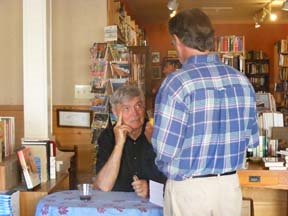 Friday evening’s book signing reception for Robert Underhill was a noteworthy event at Dog Ears Books. I had ordered a substantial number of copies of STRAWBERRY MOON, Bob’s first Leelanau murder mystery, as well as his newly released CATHEAD BAY, and while he was busy signing and I was busy selling, his wife Trudy was the evening’s gracious hostess. They both commented on the beautiful atmosphere provided by the Painted Horse Gallery, the lovely paintings making the area feel like someone’s home. Weather was perfect, too.
Friday evening’s book signing reception for Robert Underhill was a noteworthy event at Dog Ears Books. I had ordered a substantial number of copies of STRAWBERRY MOON, Bob’s first Leelanau murder mystery, as well as his newly released CATHEAD BAY, and while he was busy signing and I was busy selling, his wife Trudy was the evening’s gracious hostess. They both commented on the beautiful atmosphere provided by the Painted Horse Gallery, the lovely paintings making the area feel like someone’s home. Weather was perfect, too. 
Closing time on Saturday took me down the street to a memorial picnic for Sigrid von Bremen Thomas, author of GOODBYE STALIN. Sigrid hadn’t been interested in having a memorial, her husband Rich said. She wanted a party. The family arranged for both, but when I expressed doubt about being able to attend both, Rich insisted I come to the party.
Later, at home, my dog and I got out for a ramble. Cherries are beginning to shout with color. North Manitou Island beckoned from the horizon. Cow-vetch and St. John’s-wort triggered half a memory of a poem. “Purple and gold” is the key phrase. Any ideas, anyone?



P.S. on the vetch and vort: "Very Like a Whale," by Ogden Nash at http://www.cs.rice.edu/~ssiyer/minstrels/poems/854.html is what was in the back of my mind. A more literary mind would no doubt have gone to the original....

Labels:
authors,
books,
Dog Ears Books,
Painted Horse Gallery
Friday, July 11, 2008
Ripening
Wednesday, July 9, 2008
Why Not Fight 'Em All?
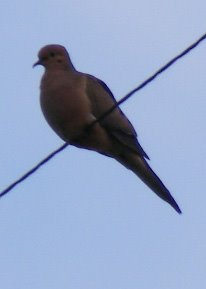 I’ve stayed away from politics with this site, for the most part, though dipping into economics from time to time. Time for a “rant,” as my son might say. It won’t be a regular feature but may occur once in a while, as the spirit moves me. I've been sitting on this one for a week.
I’ve stayed away from politics with this site, for the most part, though dipping into economics from time to time. Time for a “rant,” as my son might say. It won’t be a regular feature but may occur once in a while, as the spirit moves me. I've been sitting on this one for a week.So, why do I ever read the columns of Thomas Sowell in the Record-Eagle? Every time I do, my blood pressure soars, and his July 2 column was no exception. Right before the 4th of July, too. Sigh…. Full disclosure: I am not a historian, nor do I pretend to be one. I do not even, as David likes to say about being a doctor, play one on TV. But analyzing argument, which is what philosophers do, is analyzing argument, whether the subject be history, science, ethics or beekeeping. Validity rests on only two legs: (1) the statements used as premises must be true and (2) the conclusion(s) must follow from them. Good historians usually avoid false statements, but I have observed that their conclusions are not infrequently based on insufficient premises, though the insufficiency may go unnoticed even by the historian in his rush to prove a point. So, that’s where I’m coming from.
Thomas Sowell is concerned with patriotism. It seems, as a friend of ours observed recently, that a lot of people these days are concerned about patriotism, and many gauge it by whether or not someone flies a flag or wears a flag lapel pin or has the right sentiments displayed on a bumper sticker. Sowell has more focused concerns. He is suspicious of teachers who present peace as an ideal. If we teach that war brings suffering, he reasons, we will be pushovers. Better to sing the praises of patriotic military heroes than to soften up a generation and prepare them for defeat. That’s his line, and, eager to push his ideological agenda, he cites France as a case study. Again I sigh: Right-wing Americans love to roll their eyes at the French. Sowell would have us believe that the French rolled over for Germany in 1940 because the country’s schoolteachers had failed to promote patriotism, choosing to teach instead that the French had been victims, not heroes, during World War I.
This is a heavy charge--and a new one on me. Teachers are to blame for the fall of the Third Republic? Let’s go one step at a time.
Did, in fact, French teachers after World War I teach that their pupils’ parents had been victims rather than heroes? I cannot imagine Sowell would misrepresent a matter of historical record like school curriculum, so I’ll accept his premise, but let’s then push the “Why?” question further back. Why, after a war in which Germany was ultimately defeated, would France not be gung-ho for another round of bloodshed? --No, that way of putting the question is loaded. Let me rephrase. Why would French teachers not glorify the national victory? To answer this question, we need to look at the First World War, but it may be instructive to look back even further than that.
Eugen Weber, in FRANCE: FIN DE SIECLE (Cambridge, MA: Harvard University Press, 1986), argues that French society had been in a state of continual crisis, living under the threat of war year after year, since 1870, the date of the Treaty of Frankfurt, itself seen as an uneasy truce rather than a real treaty. It was not until 1900 that a French court of law finally decided that “Prussian” was not a derogatory term. The conviction of Captain Albert Dreyfus in 1894, William Shirer writes in THE COLLAPSE OF THE THIRD REPUBLIC: AN INQUIRY INTO THE FALL OF FRANCE IN 1940 (NY: Simon & Schuster, 1969), “sheds light on the rocky course” of France’s government leading all the way up to the Second World War. Political divisions over the Dreyfus case persisted after the verdict, and when new evidence came to light, many felt that the forgeries committed to convict the innocent soldier were the result of “patriotic devotion” to country. There was a strong sentiment that patriotism and belief in government and military leaders were more important than the guilt or innocence of one Jew held prisoner on Devil’s Island. To the glory of France, however, others put truth and justice above blind patriotism. Nevertheless, it took its toll:
“Further seeds of what was to come, like the fatal elements which begin to build up in a Greek drama, were planted in French society in this unhappy time. The divisions of a divided people were deepened, the gulf between the Right and the Left widened, and the chances of eventual conciliation between the two made more difficult, if not impossible” (Shirer, 49).
Patriotism does not, in and of itself, imply good decisions. The failures of French military leadership in the First World War were failures of vision and strategy rather than failures of patriotism. “The French High Command simply refused to believe that the main German onslaught would come through Belgium” (Shirer, 121). Both French and German generals going into the war believed the conflict would be quickly resolved. All were wrong. Disciplinary methods used to punish troops for cowardice or desertion served instead to erode morale further.
When the Armistice ending the Great War was signed on November 11, 1918, “It had cost the French 1,357,800 dead, killed in action, 4,266,000 wounded and 537,000 made prisoner or missing—exactly 73 percent of the 8,410,000 men mobilized to defend the land. The northern third of the country was in ruins from four years of battle and deliberate German destruction, the nation’s treasury was empty, the war debts piled so high that they were almost beyond counting” (Shirer, 133).
Nearly 50 years of either war or the constant threat of war; a people divided not only by politics but by religious and ethnic suspicion; a long, brutal war that claimed three-quarters of a male generation of soldiers, robbing families of husbands and fathers; farmland turned to wasteland, forests utterly erased; galloping inflation that wiped out savings. These were all demoralizing factors. (A parenthetical note on inflation: the French were thrifty as well as patriotic, but neither virtue was enough to save their country from devastation.)
I look at the small black-and-white photographs in a Ballantine paperback edition of IN FLANDERS FIELDS: THE 1917 CAMPAIGN, by Leon Wolff, and wonder how my fellow Michiganians would respond to calls for patriotism if our state lands had ever been reduced to the bloody battlegrounds of 1917 France. If we lost close to a generation of young males? If there were a history of hostile invasions onto our soil from neighboring Canada? We worry about an economic slow-down, but how would we deal with the kind of inflation France experienced between the two World Wars? An ever-widening gap between political parties and economic interests, with each side blaming the other for empty government exchequers?
It’s easy to wave a flag, to be stirred by a marching band, to feel pride in the sight of young people in uniform, and none of those are bad things in and of themselves. It should not, however, be easy to send young people to die needlessly. It should not be easy to treat those desperate for a college education or health benefits as cannon fodder to enrich those already on the top of the heap. (Nothing worth the sacrifice trickles down into the grave.) It should not be easy to bankrupt a country for the sake of a show of heroism. It should not be easy to visit suffering on people in other countries while wrapping ourselves in red, white and blue glory.
I love my country and want to be proud of it. My country’s government and certain self-styled “patriots” sometimes make it difficult. In the late fall of 2001, a couple friends and I had a very serious conversation. One was being bombarded with e-mail from old college classmates urging her to display her “patriotism” by flying a flag and refusing to hear any criticism of the government of the United States of America. Maybe that’s one way to be patriotic. It isn’t my way. I’ll repeat here what I said then: “Being an American in your own way is what being an American is all about.” That’s how I see it from where I live.
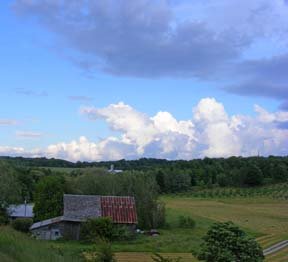
Sunday, July 6, 2008
Good Times Were Had
 The Independence Day “weekend” was five busy days long, but they were good days, and we couldn’t have asked for better weather. Oh, maybe not everyone loved the rain on Wednesday, but it watered fields and gardens, and after that there was nothing but sunshine Thursday through Sunday. On the 4th itself, the fireworks David and I saw on our way through town, returning home from a friend’s house, were stupendous. (Even when you ask in Suttons Bay, “Where are the best fireworks?” the answer is always, “Oh, Northport, no question!”) Never have we seen cars parked so far out of town along the highway as Friday evening. But we were tired and missing our dog so went home rather than join the crowds, and Sarah’s wiggly-wagging welcome more than repaid the sacrifice.
The Independence Day “weekend” was five busy days long, but they were good days, and we couldn’t have asked for better weather. Oh, maybe not everyone loved the rain on Wednesday, but it watered fields and gardens, and after that there was nothing but sunshine Thursday through Sunday. On the 4th itself, the fireworks David and I saw on our way through town, returning home from a friend’s house, were stupendous. (Even when you ask in Suttons Bay, “Where are the best fireworks?” the answer is always, “Oh, Northport, no question!”) Never have we seen cars parked so far out of town along the highway as Friday evening. But we were tired and missing our dog so went home rather than join the crowds, and Sarah’s wiggly-wagging welcome more than repaid the sacrifice.Earlier at our friend’s house, while David, our host and another guest were visiting, I walked down the path to the beach barefoot, feeling more relaxed with every step. To the north, to the south—not a soul in sight! The last light was brilliant on the tranquil water, and stones whispered to me to pick them up. First to come to my hand was a perfect 2-inch oval Petoskey. Well, when stone-picking begins like that, whatever follows is gravy.
 Back at the patio dining table, reflections in the sliding glass doors captured my attention.
Back at the patio dining table, reflections in the sliding glass doors captured my attention.  This afternoon at Dog Ears Books and the Painted Horse Gallery, true to the “You never know” theme of our lives, we were treated to an impromptu concert of folk music by the Weatherheads from Grand Rapids. Pete and Barb gave us acoustic guitar, electric bass, harmonica and vocals, and the only way it could have been better was if it had gone on all afternoon. But we were here, and they were here, and there was music and appreciation of it.
This afternoon at Dog Ears Books and the Painted Horse Gallery, true to the “You never know” theme of our lives, we were treated to an impromptu concert of folk music by the Weatherheads from Grand Rapids. Pete and Barb gave us acoustic guitar, electric bass, harmonica and vocals, and the only way it could have been better was if it had gone on all afternoon. But we were here, and they were here, and there was music and appreciation of it.Northport Calendar:
Tuesday, July 8, at 7:30 p.m. at the Leelanau Township Library, Northport author Kathleen Firestone will talk about her new book, SWIFT AS A VANISHING DREAM.
Friday, July 11, there will be a wine and cheese reception at Dog Ears Books, 106 Waukazoo Street, from 5-7 p.m. for Robert Underhill, who will be on hand to sign copies of his new mystery, CATHEAD BAY, second in the Sheriff Hoss Davis series that began with STRAWBERRY MOON. (Bookstore and gallery will be closed 2-4 p.m. to give me a chance to regroup.)
Friday, July 4, 2008
Thursday, July 3, 2008
Sarah-Kona, Kona-Sarah
 Sarah loves her neighbor dog pal, Kona, so much that the two of them remind me of the two girls in the books by Maud Hart Lovelace, playmates who were so constantly together that they were called by a single name: "Betsy-Tacy!" For Sarah, however, working dog that she is, playtime with Kona, Brandy and Riley is restricted to morning and evening romps.
Sarah loves her neighbor dog pal, Kona, so much that the two of them remind me of the two girls in the books by Maud Hart Lovelace, playmates who were so constantly together that they were called by a single name: "Betsy-Tacy!" For Sarah, however, working dog that she is, playtime with Kona, Brandy and Riley is restricted to morning and evening romps.
Wednesday, July 2, 2008
Happy Birthday to Us
 It’s almost here. July 4, 2008, will mark the 15th anniversary of Dog Ears Books in Northport, Michigan, but I’m posting the story early, since our country’s birthday is the more important reason to celebrate the Fourth, and I’ll probably be too busy that day to get anything new online. Following, then, is my essay on the history of Dog Ears Books that will appear in the August-September issue of the BookWomen journal out of St. Paul, Minnesota:
It’s almost here. July 4, 2008, will mark the 15th anniversary of Dog Ears Books in Northport, Michigan, but I’m posting the story early, since our country’s birthday is the more important reason to celebrate the Fourth, and I’ll probably be too busy that day to get anything new online. Following, then, is my essay on the history of Dog Ears Books that will appear in the August-September issue of the BookWomen journal out of St. Paul, Minnesota:--
“You’re living my dream!” people sometimes exclaim. “When I retire, I want to open a bookstore!” That is a sensible approach. Have a career first, arrange for reliable retirement income, then open a bookstore as a hobby. I didn’t do it that way.
I worked in offices for two decades, and when my son turned 18, I was the one who went away to school. Returning to northern Michigan to complete my doctoral dissertation away from the distractions of teaching, I needed work, and—no surprise here--my husband and I had too many books for our small house. “We have to be ruthless,” he said to me, attacking his bookshelves while I pawed through my boxes. “Everything we’re not going to re-read has to go!” Soon the living room floor was filled with stacks of boxes of very good books.
We had enough books, clearly, to open a small shop, and someone we knew had a vacant shed we could rent for the season in Northport. No business plan, no research, no retail experience. Swim or sink!
Ours were used books. We had a dog. Dog Ears! I can tell much of its story in a series of partial lists.
Here are some things I remember from that summer of 1993: putting up our homemade shelves in June, feeling like a real, working part of the community getting ready for the tourist season… sweeping the sidewalk every morning in July, nervous about meeting “strangers” again that day…overhearing passers-by repeat the name of our shop, “Dog Ears,” over and over again in delight… feeling gratified every time someone asked, “Do you have a poetry section?” Some evenings we opened the shop again after dinner, and as darkness fell, the little lighted shed looked and felt cozier and cozier. I remember meeting for the first time people who are still my friends today, and I remember also the first books they bought from me that summer 15 years ago.
There were lessons to learn: how to identify first editions; how important dust jackets are to value; how easy it is to buy too many books and to pay too much for them; that it’s never a good idea to store books in a basement; that books in storage don’t pay their rent; that even free books can be costly to store; that sometimes “No, thank you” is the best answer you can give; that the majority of Americans consider themselves shy; that most people are not as shy with strange dogs as they are with strange human beings; that almost everyone who loves books thinks that “No one reads books any more.”
We moved Dog Ears Books to nearby Traverse City the following spring, but when the two-year lease ran out I was ready to come back to Northport. A booklet I made up for our tenth anniversary noted various milestones in that decade: creation of a garden outside the shop on the corner of Mill and Nagonaba; our old dog Nikki’s participation in the Northport Dog Parade; adding the first new books to my shop inventory; moving to a larger, more comfortable building (with plumbing and heat!) next door; completing my Ph.D. in philosophy; shifting from community college instruction in Traverse City to tutoring part-time in the local public school.
Because the truth is (and this will not surprise BookWomen readers, I’m sure) that making a living with an independent bookstore is not an easy gig. I won’t list the sacrifices (hint: one is health insurance), and I’m certainly not saying the joys don’t outweigh the agonies, but I’ve supplemented bookstore income over the years in a variety of ways: teaching, tutoring, freelance editing, garden maintenance and orchard work. Also, anyone in the book world can attest to how much that world has changed in the last 15 years. Just when I thought I had it figured out, “it” would change, and that’s been true of book searches and online selling and library book sales. It’s also been true of the economy in general, not only in northern Michigan but across the country. Again, swim or sink!
A couple of years ago, midway through a discouraging winter, a great piece of good fortune came my way. An architectural designer from Grand Rapids, married to a well-established artist and preparing a career change of his own from architecture to fine art, bought an old building in downtown Northport, the old Ford dealership showroom and garage from the second decade of the twentieth century. Woody Palmer wanted to launch an art gallery and needed someone to do sales. We first danced cautiously around the idea of a business collaboration at a friend’s winter place in Suwanee, Florida, and by the following December I had a crew of volunteers helping me move my bookstore back to the street where it had been born. Dog Ears Books and the Painted Horse Gallery—our own fancy dog and pony show on Waukazoo Street! It was exciting. It was nerve-wracking. It was a leap of faith. When I reflect on the 15-year history of Dog Ears Books, though, I realize all those things can be said of every step along the way. It helps to have a dream and to be independent in spirit. It also helps to be as stubborn as a mule.
Our little village is at the end of a peninsula, and the regional economy is mixed, agriculture and tourism, both seasonal in nature. Declining public school enrollment led to community crisis a few years back when one faction thought the high school should be closed for good. (It’s still open.) The town’s first-ever sewer system is now almost completed, and real estate transfers and remodeling projects are finally going forward downtown, but when we invited the public into our remodeled space at 106 Waukazoo for our Grand Opening last year, one of the feelings most often expressed by enthusiastic visitors and clientele was gratitude. Residents were thrilled that the bookstore hadn’t left town or gone out of business, and they were grateful to Woody for buying and remodeling the building to house Dog Ears Books and his own beautiful new gallery. Waukazoo Revival, I call it.
Contingency over time becomes necessity. You wouldn’t miss the person you love after decades together if you’d never met in the first place. It was just chance that David and I found the first bare-bones, no-frills shed in Northport when our personal home library threatened to bury us alive, but now Northport is part of Dog Ears Books, as the bookstore is part of the village. I could have been something other than a bookseller, but along came a choice of roads, and this is the direction I took.
We have a new, young dog now. Old Nikki and I (younger then) both had to overcome our shyness in the bookstore, which was good for both of us. Nowadays, although Sarah and I sometimes chafe at the long hours indoors, she’s a terrific after-hours companion in woods and field. David’s enthusiasm for schlepping boxes of books has waned; on the other hand, he's still brimming with ideas for the bookstore and very satisfied, as am I, with all the wonderful people we continue to meet, thanks to Dog Ears Books.
So after 105 dog years in the book business, I can say, “It’s a hard way to make a living, but it’s a good life.”
(Thanks to Mollie at BookWomen for allowing this sneak preview to their late summer issue.)
Labels:
bookselling,
Dog Ears Books,
Northport,
Painted Horse Gallery
Tuesday, July 1, 2008
Town and Country
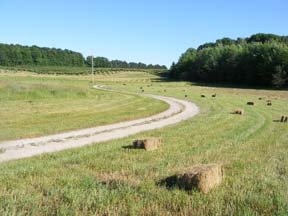 Vicariously in New York with Emily (see yesterday’s post), I learned that it was Marcella Hahner, buyer for the Book Section of Marshall Field’s in Chicago, who originally came up with the idea of inviting authors to the store to sign books.
Vicariously in New York with Emily (see yesterday’s post), I learned that it was Marcella Hahner, buyer for the Book Section of Marshall Field’s in Chicago, who originally came up with the idea of inviting authors to the store to sign books. “When I met Marcella only a little over ten years after the establishment of the department, she had built it into the biggest retail book business in the world…. She had established and she maintained her absolute sovereignty over publishers by the artful device of selling more of their books than any other retailer even approached. Every bookseller the country over based his order on the number of volumes Mrs. Hahner had requested.” Who knew? One little woman in the Second City led the way.
While Mrs. Hahner did invite authors to Marshall Field’s Book Section to sign their books, the signings were not generally public events but intimate tea parties held in the buyer’s office. If Mrs. Hahner liked the author (and she usually did) and trusted him (always “him”) around young women, Emily was invited, meeting many famous writers of the era. (So much for those snooty friends of hers who left her out of their dinner dance party, I thought with satisfaction as I read this chapter.) But in 1918 Marcella Hahner inaugurated a Book Fair at the store, with 56 publishers and many live authors. “The authors spoke and autographed their books for thousands of people, most of whom until Marcella brought their attention to the matter had never owned nor particularly wanted to own an autographed copy of anything.”
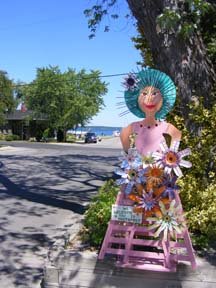
 I had to tear myself away from housecleaning and reading (which was more difficult?) to get up to Northport about mid-afternoon, checking with Bruce on bookstore happenings of the day before making my usual rounds of the village with Sarah. Thanks to the creative and industrious David Chrobak, there are new ladies around town, colorful and stylish, welcoming visitors for the week of the 4th and beyond. Here are a couple of them. (No one ever knows what David will come up with next.) It was a busy late afternoon at Dog Ears Books, too, visiting with and selling books to out-of-town customers and planning with Woody for a show in the gallery in three weeks’ time.
I had to tear myself away from housecleaning and reading (which was more difficult?) to get up to Northport about mid-afternoon, checking with Bruce on bookstore happenings of the day before making my usual rounds of the village with Sarah. Thanks to the creative and industrious David Chrobak, there are new ladies around town, colorful and stylish, welcoming visitors for the week of the 4th and beyond. Here are a couple of them. (No one ever knows what David will come up with next.) It was a busy late afternoon at Dog Ears Books, too, visiting with and selling books to out-of-town customers and planning with Woody for a show in the gallery in three weeks’ time.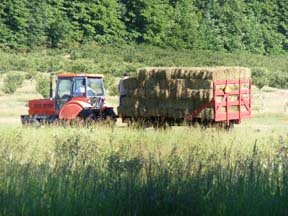 Later, back home, I found a hay crew in the fields, loading wagons with hay bailed only hours before. Yes, the sun shines, so….
Later, back home, I found a hay crew in the fields, loading wagons with hay bailed only hours before. Yes, the sun shines, so….We’re all trying to “make hay” this time of year, which reminds me to remind everyone that Saturday is the Promise picnic and silent auction at Marina Park. The Promise scholarship program for Northport graduates is off to a good start and deserves continuing support. Check their website (Northport Promise) for more information and for a list of items included in the auction.
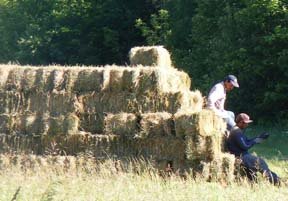
Labels:
agriculture,
books,
Northport,
Northport School
Subscribe to:
Posts (Atom)

